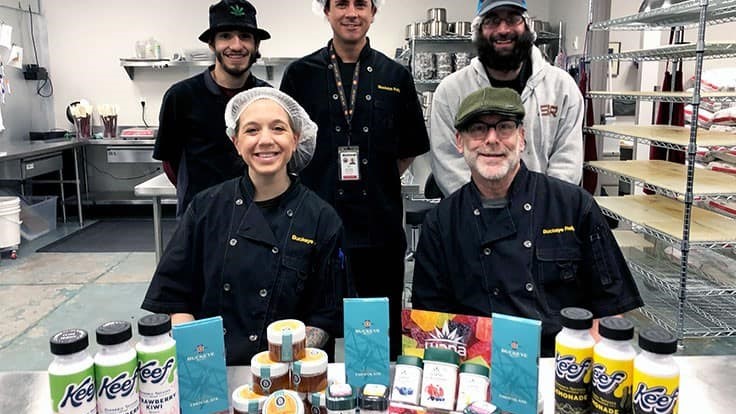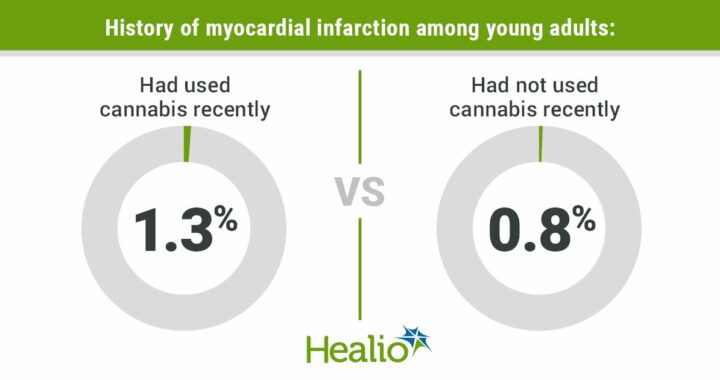Buckeye Relief Finds Top Shelf for Carefully Crafted Edibles
12 min read
Buckeye Relief | buckeyerelief.com
The Buckeye Relief infused-foods team, including Kitchen Manager Emily Rollo (front left), Executive Chef Marc London (front right), Kitchen Tech Lupe Rivera (back row, from left), Kitchen Tech Ricardo Yepez and Assistant Kitchen Manager Ryan Fatica, carefully craft a line of cannabis edibles with a focus on taste and effectiveness.
The first time Marc London received a complaint about the taste of his chocolate, there was only one response he deemed appropriate.
“Thank you,” said London, the executive chef at Buckeye Relief, a medical cannabis cultivator and processor in Eastlake, Ohio, about 15 miles northeast of Cleveland, where he and Kitchen Manager Emily Rollo carefully craft infused foods with a focus on taste and effectiveness. Their line of edibles includes chocolates; locally sourced honey; Wana gummies; and Keef Brands, an infused beverage available in lemonade and strawberry kiwi.
Tony Lange | cannabisbusinesstimes.com
Buckeye Relief’s 25,000-square-foot indoor grow facility became operational in July 2018 in Eastlake, Ohio.
Buckeye Relief, which has a 25,000-square-foot indoor grow facility that became operational in July 2018, launched its kitchen operation shortly after getting an extraction license in the spring of 2019. While Ohio legalized medical cannabis in 2016, statewide sales didn’t begin until early 2019.
An executive chef by trade, London always worked with chocolate when he owned a prepared-foods store and a catering business in the mid-80s, he said. Since London believes chocolate is one of the most complex food products on the planet to work with, he made it his mission to search high and low for the best commodity on the globe to infuse, he said.
Buckeye Relief co-founders Andy Rayburn, CEO, and Scott Halloran, chief operating officer, began the planning phases of their company in 2016, shortly before Ohio’s passage of medical cannabis House Bill 523—two years before Buckeye Relief became operational—which provided London ample time to track down the right chocolate for the operation.
“I was even down in Ecuador looking at chocolates down there, because I think Ecuador is one of the best producers of chocolate in the world, even though most of our chocolate comes from South Africa,” London said. “And I just happened to be in Ecuador, so … I just started doing some research down there and brought some back here.”
Tony Lange | cannabisbusinesstimes.com
Buckeye Relief offers a 72% cacao dark chocolate, a smooth and creamy milk chocolate and a 1-to-1 ratio marble chocolate year-round.
While his prospects from Ecuador showed promise, London and his team at Buckeye Relief eventually decided on a Belgian chocolate to infuse in their kitchen. They now offer a 72% cacao dark chocolate, a smooth and creamy milk chocolate and a 1-to-1 ratio marble chocolate, as well as seasonal flavors, like a white-minted chocolate with sprinkles during December holidays.
Key to Buckeye Relief’s line of infused foods is the kitchen’s focus on producing edibles that don’t have the flowery or grassy taste of the cannabis plant, and that goes for all of the edibles, not just the chocolate, London said. “I wanted products that tasted just like the ingredients that went into it with the exception of the extraction ingredients,” he said.
In turn, London steered clear from compound chocolate, which can be melted down and deposited into molds without being tempered, and put his attention on “real” chocolate, which requires the breaking down of fats and waxes before being tempered back to its original state with the cannabis extract infused, he said. The end product retrieves a nice, glossy finish, he said.
“When you look at really good chocolate, you’re like, ‘Wow, that is beautiful,’” London said.
He and his team—which, along with Rollo, also includes Assistant Kitchen Manager Ryan Fatica and kitchen techs Lupe Rivera and Ricardo Yepez—were not just after an infused chocolate that had good health benefits, but a product that both presented itself well and had great taste, he said.
So, when Buckeye Relief Communications and Marketing Director Leslie Brandon notified London that she received a complaint about the taste of his chocolate, specifically regarding how one consumer “could not taste the cannabis” in the product, there was only one response he deemed appropriate: “Thank you.”
“And that’s literally happened numerous times where I’ll get emails from Leslie, ‘Marc, we just got a complaint. They can’t taste anything in the chocolate,’” London said. “And the first time she ever sent that to me, I just emailed her back, ‘OK, I’m going to take that as the ultimate compliment, because that’s what I set out to achieve from day one.’”
London also attributed the taste of Buckeye Relief’s chocolate to the extraction team’s understanding of how to process a cleaner and redefined end product from the plant to infuse into the edibles, he said.
Planting Their Roots
Still in its infancy, Ohio’s medical cannabis program has more than 176,000 registered patients as of Feb. 28, 2021, according to the Ohio Medical Marijuana Control Program. On the retail front, Ohio averaged $5.7 million in total product sales per week through the first 10 weeks of 2021, compared to an average of $2.5 million per week during the same timeframe in 2020, according to the control program.
But London and Rollo’s connection to cannabis and to the kitchen extends beyond Buckeye Relief. Friends with Rayburn for more than 30 years, London’s first customer for his catering business in the ‘80s was Rayburn’s ex-wife, he said.
“That’s how I met Andy, and what bonded us was our love of music, live music, and our love for sports,” London said. “I’ve seen over 250 [Grateful] Dead shows in my life. A hundred of them were probably with Andy. And we haven’t stopped yet. So, when we had that jam-band connection, that carried us through all these years. We’ve gone all over the place. It’s great.”
On Dec. 5, 2018, the night before Buckeye Relief’s first harvest and the plants’ last night in the flower room, Rayburn gave the crop a special treatment. He played the Grateful Dead’s legendary 1977 concert at Cornell University’s Barton Hall over the PA system, making sure the plants had a “good last evening,” Rayburn said.
RELATED ARTICLE: Buckeye Relief’s First Harvest in Ohio’s Medical Marijuana Market
After his prepared-foods store and catering business, which he transitioned into a smoothie juice bar operation, London went on to extend his expertise in the publishing industry, where he built a Cleveland-based magazine called Fine Lifestyles that shared editorial about the people, cultures and businesses that make up Northeast Ohio.
London said he’d still be running that magazine if it were not for Rayburn.
“I’d still be in that business if Mr. Andy Rayburn hadn’t said, ‘Marc, I think I’m going into the cannabis business,’” London said. “And I heard that and said, ‘OK, well, if he’s going in the cannabis business, then I’m going into the cannabis business—just let me know when and where.”
Once Buckeye Relief built its facility and started its grow, it was just a matter of time before the company received its extraction license and opened a kitchen for infused foods. Until then, London sometimes helped out in other facets of the operation, including trimming plants. That’s where he first crossed paths with Rollo.
Intern to Kitchen Manager
Tony Lange | cannabisbusinesstimes.com
Buckeye Relief Kitchen Manager Emily Rollo got her start as an intern in the trim department in 2018.
Rollo first started working at Buckeye Relief as an intern in the trim department in 2018, an entry-level, yet important phase of cannabis cultivation.
Working in the restaurant industry for five years to help put herself through college, Rollo graduated with a bachelor’s degree in liberal arts and earned a certificate in non-profit leadership, before starting a short career in the advertising industry, where she worked sales and marketing.
During that time, Rollo had a grandmother who struggled with opioids and being able to control her doses, she said. That was around the same time Ohio passed its medical cannabis bill, which sparked Rollo’s interest in researching related opportunities before networking and eventually getting her foot in the door at Buckeye Relief, she said.
“I came from working in the advertising industry, which I really loved my job,” Rollo said. “I really enjoyed it. But I wasn’t feeling fulfilled, you know, I wanted to help people and I wanted to feel like I had that purpose.”
Once in the door, Rollo’s journey shifted toward making herself standout among 30-some interns in the trim department, she said.
“I had to create a system for myself and a strategy for myself to kind of set myself apart and start networking with people,” Rollo said. “I spotted Marc in the trim room and just started talking to him, chatting with him. Over conversation, I was able to figure out his history—I didn’t know at that point that he was in charge of the kitchen. I didn’t know at that point that he was hired in. I just knew that he was back there helping us trim.”
Diving deeper into conversation with London and picking his brain about his expertise and his soon-to-be kitchen operation, Rollo quickly went from intern to kitchen manager in roughly a year. Through her desire to be on a team that provides edibles for patients in Ohio, Rollo travelled out to Colorado with London in July 2019 to train under experts from Wana Brands, a U.S. leading infused-products company known for its gummies.
Gummy Trends
Shelby | Adobe Stock
Cannabis-infused gummies are the most popular edible in the U.S.
According to cannabis market research expert BDSA, a consumer insights data report from September 2020 revealed that infused gummies made up 84% of candy ingestible sales at that point in the year across Arizona, California, Colorado, Nevada and Oregon. In addition, 60% of U.S. edible users reported consumption of infused gummies, while baked goods were the second most popular ingestible product at 46%. And 33% of U.S. ingestible consumers cited gummies as their preferred type of edible, with a 15-point margin over baked goods as the next most popular preferred ingestible product.
“Seeing how the sales trends go, as legalization spreads throughout the United States, I saw this big opportunity that this is going to be the future of the industry,” Rollo said. “This is going to be the future of dosing. People, especially the older generations, love how convenient it is. You don’t have to smoke it. It’s something you can keep in your pocket and dose throughout the day. So that is kind of what really, really sparked my interest in that part of the industry, [where] I really saw myself thriving.”
After their weeklong training with Wana in Colorado, Rollo and London received additional hands-on instruction from Wana experts, who flew out to Ohio for detailed recipe explanations at Buckeye Relief.
And in order to meet testing standards in Ohio, Rollo said she and the Buckeye Relief team fine-tuned their gummy trials for maybe six to nine months before finally dialing in their operation. Now, a team of three to four people in the kitchen can produce anywhere from 40,000 to 70,000 gummies in a typical day, Rollo said.
In order to be more efficient, the kitchen team sometimes operates in longer shifts, working from Monday through Thursday, so that it only has to go through the time-consuming processes of setting up and cleaning up four times in a week rather than five times, Rollo said.
“I am extremely passionate in every single batch that I make, you know, my passion shows through it,” she said. “So definitely the gummies [are my passion], cause it’s kind of in my heart and soul from the beginning. I kind of had to go through a lot of testing issues, you know, to kind of get that formulation correct on it for probably six to nine months until we really dialed it in. So, yeah, it’s been a journey.”
The Buckeye Relief kitchen team produces several different cannabidiol (CBD)-to-tetrahydrocannabinol (THC) ratios in gummies. For example, there’s a five-to-one pomegranate blueberry acai gummy that has 25 milligrams of CBD to 5 milligrams of THC, which is popular among people who haven’t tried edibles before and are interested in the micro-dosing market, Rollo said. And then there are strawberry lemonade and watermelon flavors that include a one-to-one ratio of 10 milligrams of CBD to 10 milligrams of THC, while more exotic flavors, like yuzu, offer a two-to-one ratio.
Meanwhile, Buckeye Relief also produces gummies that are straight THC, including 10-milligram pieces as well as a new macro line of 30-milligram gummies in raspberry-limeade and blood orange flavors, which are for the more experienced consumers, Rollo said.
The specific flavors come from proprietary blends of terpenes—aromatic compounds found in many plants, including cannabis—that are picked out by Wana, Rollo said. In addition to flavoring, terpenes also provide different effects, she said.
“So, the mango is more of the sativa, which has the uplifting effects,” she said. “Indica more for the asleep. And hybrid obviously for a little bit of both.”
Attention is in the Details
When it comes to creating products that not only land on the shelves at dispensaries, but also stay on those shelves, Rollo and London both said their efforts boil down to running a detail-oriented operation.
Tony Lange | cannabisbusinesstimes.com
Buckeye Relief’s flower room includes several cannabis varieties.
“We operate exactly like any other [non-cannabis] medical facility in the state of Ohio,” Rollo said. “We want to make sure that we have a professional representation of how we operate. We’re trying to prove ourselves in some ways, showing that we are this legitimate business, and this is a medicine that helps people.”
On the edibles side of the industry, London said his team treats infused foods like artisanal products. For example, one batch will generate 700 gummies—only a fraction of a daily production. But rather than use a bigger cooking pot, the team at Buckeye Relief controls the quality of each gummy by simply producing more batches, London said. The same dialed-in concept applies to chocolates, he said.
“I could take a giant chocolate tank of 200 gallons of chocolate and fuse the whole thing and then start pumping it out,” he said. “I am not going to end up controlling the quality or the potency the way I can in a 15-pound run.”
Each 15-pound run will produce about 120 bars of chocolate, London said. If market demand increased beyond Buckeye Relief’s current output, then the best avenue to scale up production and maintain the quality of the brand would be to train more staff to handle more runs, he said.
Another factor pertaining to chocolate, especially the volatility of milk chocolate, is humidity, which can create a bloom, or a white, shadowy appearance that puts an eyesore on the presentation to each bar, London said.
“Up until this past summer, when I put new dehumidifiers in here, I had to produce a lot of my milk chocolate in the springtime,” he said. “There’s just too much moisture in the [summer] air. You can’t get it to cool down properly and harden properly. So, it really, it’s not as much what we produce on a daily/weekly basis, but it’s how do we control it so we can put out the highest quality year-round.”
Buckeye Relief also has a brand of locally sourced raw honey that is harvested using natural methods and then infused with a little extra buzz. While the company has its own beehives, it doesn’t have enough to keep up with demand. In turn, Buckeye Relief connected with a local beekeeper from Bainbridge Township, in neighboring Geauga County, who provides a few hundred gallons of honey any time the kitchen needs it, London said.
And then Buckeye Relief’s line of Keef—a brand in the cannabis beverage space that was originally launched in 2010 in Boulder, Colorado—includes a strawberry kiwi beverage that tastes similar to flavored water and a lemonade that tastes like a powdered-beverage mix, London said.
“I think the market is going to really, really enjoy it,” he said. “If I was making that beverage and when you drank it you were like, ‘Oh my, god. What’s that bitter, nasty plant taste?’ we would never have that product here at Buckeye Relief.
“One of the things is, we have worked really, really hard for shelf space at dispensaries. So, our commitment is, we worked so hard to get it, we can’t lose that shelf space, which means we need to be able to duplicate and produce enough to never run out. And some products just aren’t designed for that.”








 Protected by Patchstack
Protected by Patchstack